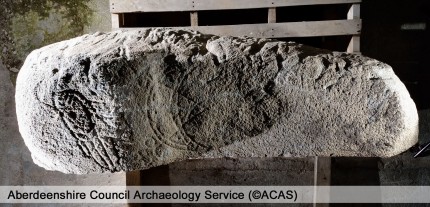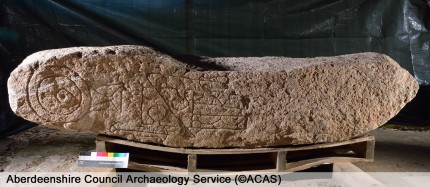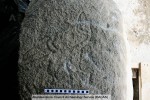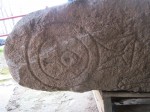

In May of last year, a farmer ploughing a field in Dandaleith, near Craigellachie in northeastern Scotland, encountered an intriguing obstacle. The landowner reported to the authorities that he had “broken his plough on a rather large stone with some sort of carving on one side,” but he was underestimating it. The solid pink granite stone actually has carvings on two sides, which makes it rare, and those sides are adjacent, which may make it unique.
Experts found that the boulder, which is nearly five and a half feet long and weighs almost 1,500 pounds, is a Class I Pictish Symbol Stone, meaning it’s an unshaped stone incised with symbols but no cross. This is the earliest type of symbol stone, and the Dandaleith Stone may date to as early as 500 A.D. The symbols on one face are an eagle with a crescent and V-rod underneath it. On the adjacent face there’s a mirror case symbol (a circle atop a rectangle) with a notch rectangle and Z-rod symbol underneath.
 The symbols have been typed and categorized from the 350 or so stones that have been found, but experts still don’t know what they mean or how the stones were used. One theory is that the symbols represent a kind of heraldry for important families. The stones could have been grave markers (although archaeological evidence of burials associated with Pictish Symbol Stones is sparse) or perhaps boundary markers. For more information about the Picts and the symbol carvings, see Historic Scotland’s dedicated website.
The symbols have been typed and categorized from the 350 or so stones that have been found, but experts still don’t know what they mean or how the stones were used. One theory is that the symbols represent a kind of heraldry for important families. The stones could have been grave markers (although archaeological evidence of burials associated with Pictish Symbol Stones is sparse) or perhaps boundary markers. For more information about the Picts and the symbol carvings, see Historic Scotland’s dedicated website.
Dr David Clarke, former Keeper of Archaeology at the National Museum of Scotland, said: “The presence of two sets of symbols on a single stone is itself a very unusual feature relative to the corpus of symbol-bearing stones, but the presence of two sets of symbols on adjacent faces may be unique. The corresponding orientation of the sets of symbols is also a very unusual feature.”
The stone was declared a Treasure Trove following its discovery, and was reported to Aberdeenshire Council Archaeology Service (ACAS), who act as the regional archaeology service for Moray Council. Claire Herbert, regional archaeologist at ACAS, said: “Members of the public regularly contact the Archaeology Service about artefacts they have found, but the reporting of the Dandaleith Stone was something truly unexpected, a real rarity. I would like to thank the ploughman and landowner for reporting their find to us, and for their continued help and cooperation.
“To our knowledge, this is a truly unique find which has the potential to alter our understanding of Pictish Symbol Stones. We are privileged to be involved in the continued protection of such a wonderful object.”
 As per the Treasure Trove law, once an object is declared treasure, the Scottish Archaeological Finds Allocation Panel (SAFAP) determines which of the interested museums will be allocated the artifact and what sum it will pay the finder as an ex gratia payment. The amount of the payment is determined by how much it would cost to purchase an equivalent object on the antiquities market. In March of this year, the SAFAP allocated the Dandaleith Stone to the Elgin Museum which is just 15 miles north of Dandaleith.
As per the Treasure Trove law, once an object is declared treasure, the Scottish Archaeological Finds Allocation Panel (SAFAP) determines which of the interested museums will be allocated the artifact and what sum it will pay the finder as an ex gratia payment. The amount of the payment is determined by how much it would cost to purchase an equivalent object on the antiquities market. In March of this year, the SAFAP allocated the Dandaleith Stone to the Elgin Museum which is just 15 miles north of Dandaleith.
While the museum raises the funds for the payment, display and transportation of this large and heavy piece of granite, the stone is being conserved and documented at Graciela Ainsworth Sculpture Conservation in Edinburgh.